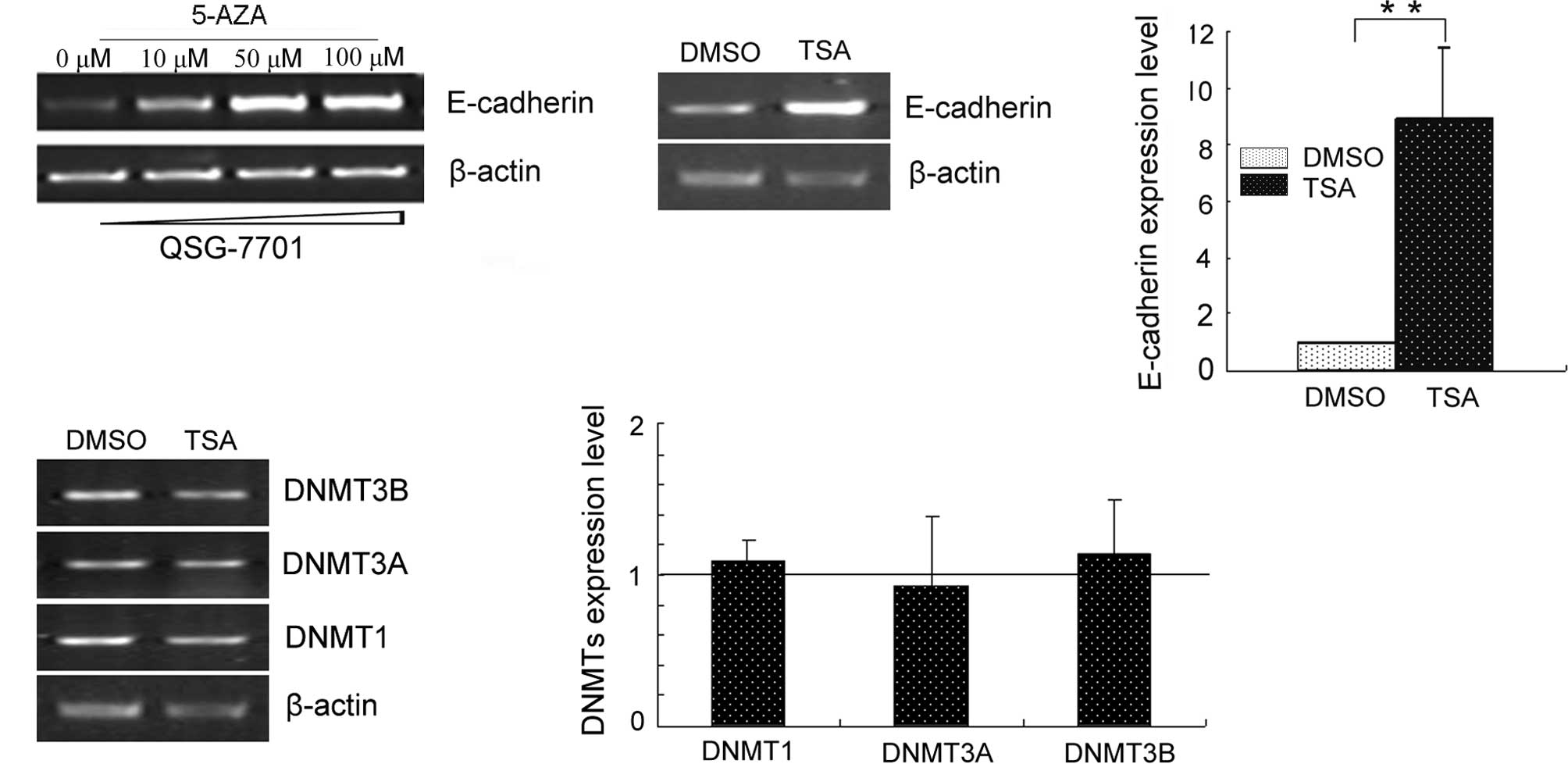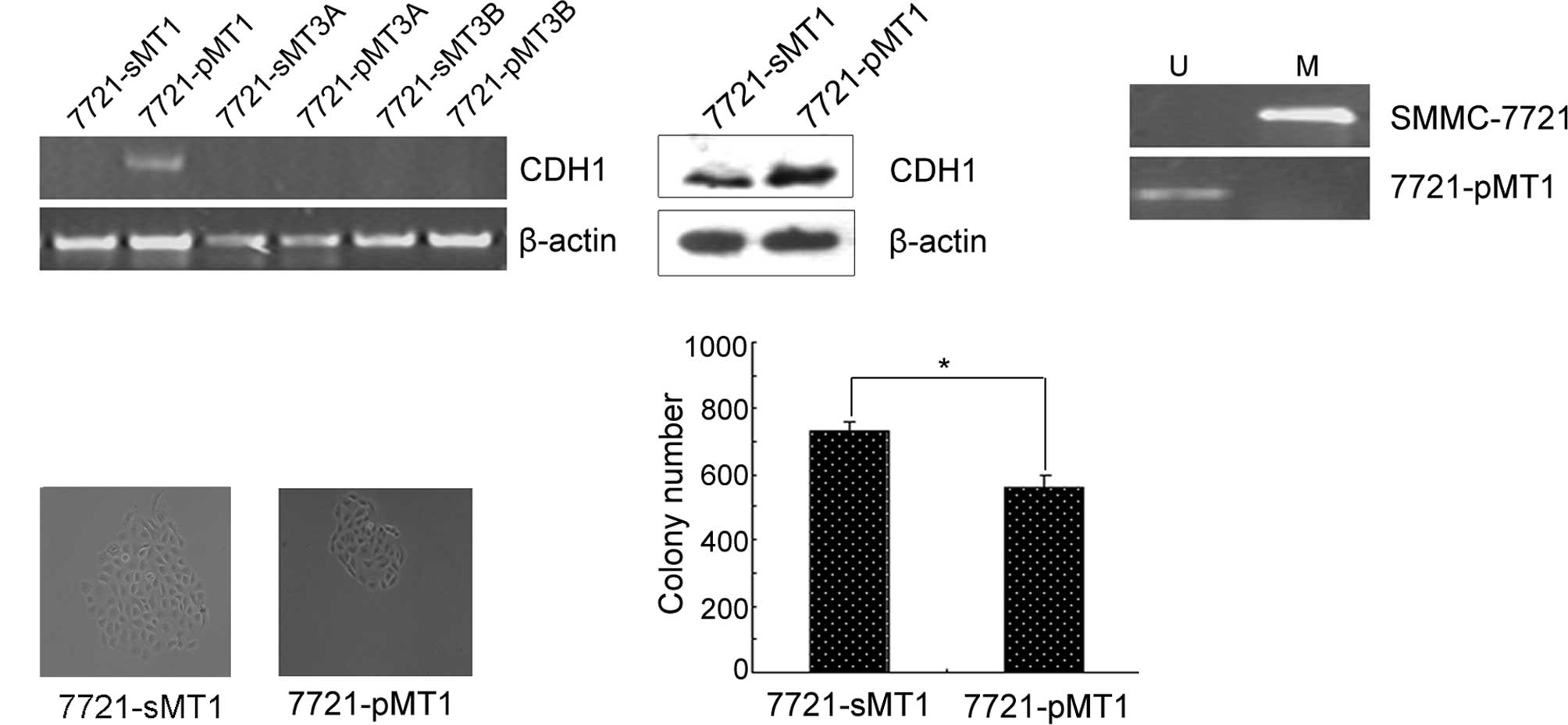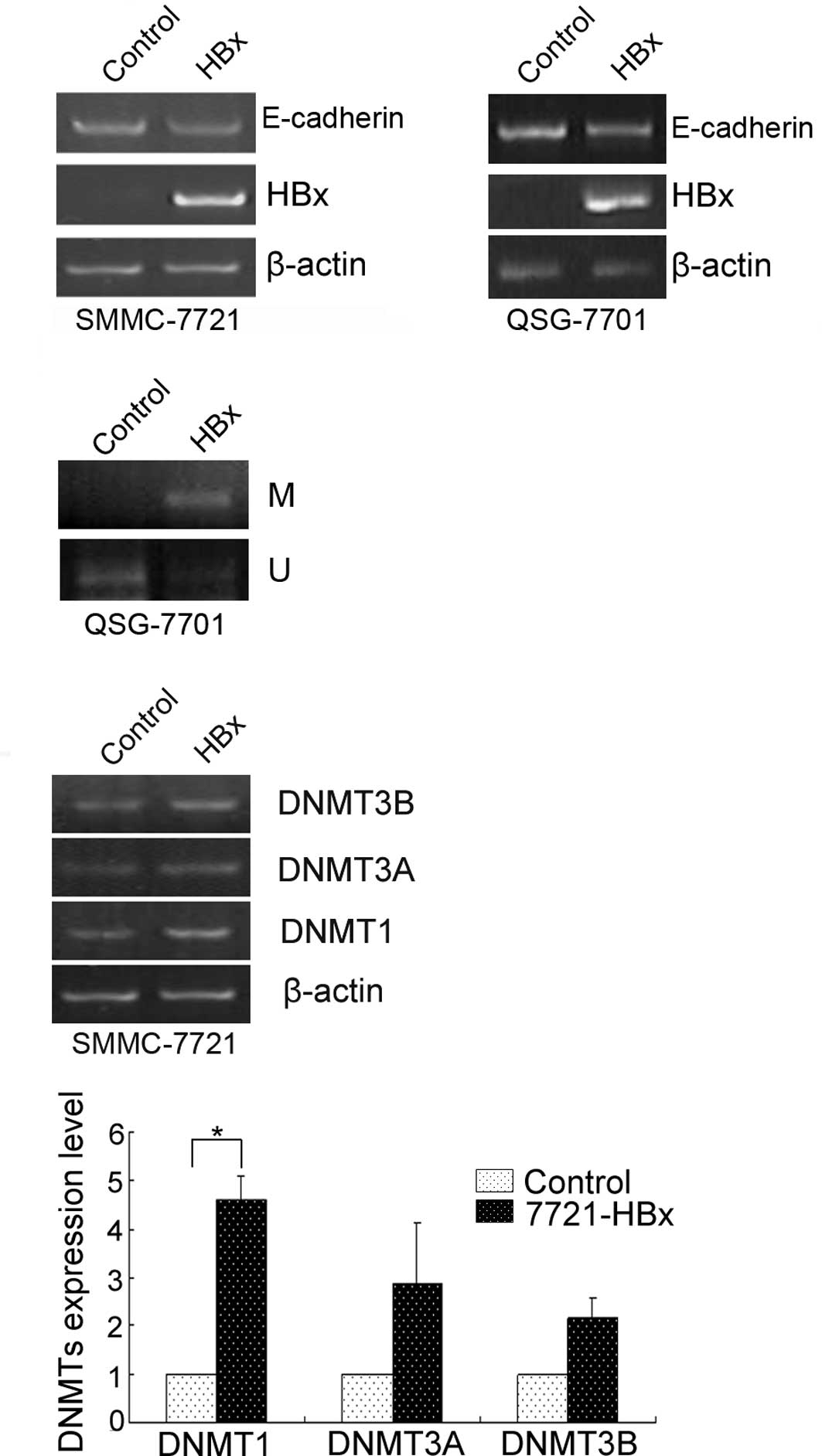|
1.
|
Takeichi M: Cadherin cell adhesion
receptors as a morphogenetic regulator. Science. 251:1451–1455.
1991. View Article : Google Scholar : PubMed/NCBI
|
|
2.
|
Hirohashi S and Kanai Y: Cell adhesion
system and human cancer morphogenesis. Cancer Sci. 94:575–581.
2003. View Article : Google Scholar : PubMed/NCBI
|
|
3.
|
Momparler RL and Bovenzi V: DNA
methylation and cancer. J Cell Physiol. 183:145–154. 2000.
View Article : Google Scholar
|
|
4.
|
Hazan RB, Qiao R, Keren R, Badano I and
Suyama K: Cadherin switch in tumor progression. Ann NY Acad Sci.
1014:155–163. 2004. View Article : Google Scholar : PubMed/NCBI
|
|
5.
|
Calvisi DF, Ladu S, Conner EA, Factor VM
and Thorgeirsson SS: Disregulation of E-cadherin in transgenic
mouse models of liver cancer. Lab Invest. 84:1137–1147. 2004.
View Article : Google Scholar : PubMed/NCBI
|
|
6.
|
Huang GT, Lee HS, Chen CH, Sheu JC, Chiou
LL and Chen DS: Correlation of E-cadherin expression and recurrence
of hepatocellular carcinoma. Hepatogastroenterology. 46:1923–1927.
1999.PubMed/NCBI
|
|
7.
|
Wei Y, van Nhieu JT, Prigent S,
Srivatanakul P, Tiollais P and Buendia MA: Altered expression of
E-cadherin in hepatocellular carcinoma: correlations with genetic
alterations, beta-catenin expression and clinical features.
Hepatology. 36:692–701. 2002. View Article : Google Scholar : PubMed/NCBI
|
|
8.
|
Ihara A, Koizumi H, Hashizume R and
Uchikoshi T: Expression of epithelial cadherin and alpha- and
beta-catenins in nontumoral livers and hepatocellular carcinoma.
Hepatology. 23:1441–1447. 1996.PubMed/NCBI
|
|
9.
|
Howard EW, Camm KD, Wong YC and Wang XH:
E-cadherin upregulation as a therapeutic goal in cancer treatment.
Mini Rev Med Chem. 8:496–518. 2008. View Article : Google Scholar : PubMed/NCBI
|
|
10.
|
Liu J, Lian Z, Han S, Waye MM, Wang H, Wu
MC, Wu K, Ding J, Arbuthnot P, Kew M, Fan D and Feitelson MA:
Downregulation of E-cadherin by hepatitis B virus X antigen in
hepatocellullar carcinoma. Oncogene. 25:1008–1017. 2006. View Article : Google Scholar : PubMed/NCBI
|
|
11.
|
Yoo CB and Jones PA: Epigenetic therapy of
cancer: past, present and future. Nat Rev Drug Discov. 5:37–50.
2006. View
Article : Google Scholar : PubMed/NCBI
|
|
12.
|
Fan H, Zhao Z, Quan Y, Xu J, Zhang J and
Xie W: DNA methyltransferase 1 knockdown induces silenced CDH1 gene
reexpression by demethylation of methylated CpG in hepatocellular
carcinoma cell line SMMC-7721. Eur J Gastroenterol Hepatol.
19:952–961. 2007. View Article : Google Scholar : PubMed/NCBI
|
|
13.
|
Xu J, Fan H, Zhao ZJ, Zhang JQ and Xie W:
Identification of potential genes regulated by DNA
methyltransferase 3B in a hepatocellular carcinoma cell line by RNA
interference and microarray analysis. Yi Chuan Xue Bao.
32:1115–1127. 2005.PubMed/NCBI
|
|
14.
|
Herman JG, Graff JR, Myohanen S, Nelkin BD
and Baylin SB: Methylation-specific PCR: a novel PCR assay for
methylation status of CpG islands. Proc Natl Acad Sci USA.
93:9821–9826. 1996. View Article : Google Scholar : PubMed/NCBI
|
|
15.
|
Zhang H, Xiao W, Liang H, Fang D, Yang S
and Luo Y: Demethylation in the promoter area by the antisense of
human DNA MTase gene. Zhonghua Zhong Liu Za Zhi. 24:444–447.
2002.PubMed/NCBI
|
|
16.
|
Kanai Y, Ushijima S, Hui AM, Ochiai A,
Tsuda H, Sakamoto M and Hirohashi S: The E-cadherin gene is
silenced by CpG methylation in human hepatocellular carcinomas. Int
J Cancer. 71:355–359. 1997. View Article : Google Scholar : PubMed/NCBI
|
|
17.
|
Feitelson M: Hepatitis B virus infection
and primary hepatocellular carcinoma. Clin Microbiol Rev.
5:275–301. 1992.PubMed/NCBI
|
|
18.
|
Murakami Y, Hayashi K and Sekiya T:
Aberration of the tumor suppressor p53 and retinoblastoma in human
hepatocellular carcinomas. Cancer Res. 51:5520–5525.
1991.PubMed/NCBI
|
|
19.
|
Liao C, Zhao M, Song H, Uchida K, Yokoyama
KK and Li T: Identification of the gene for a novel liver-related
putative tumor suppressor at a high-frequency loss of
heterozygosity region of chromosome 8p23 in human hepatocellular
carcinoma. Hepatology. 32:721–727. 2000. View Article : Google Scholar : PubMed/NCBI
|
|
20.
|
Constantinides PG, Jones PA and Gevers W:
Functional striated muscle cells from non-myoblast precursors
following 5-azacytidine treatment. Nature. 267:364–366. 1977.
View Article : Google Scholar : PubMed/NCBI
|
|
21.
|
Yoshida M, Horinouchi S and Beppu T:
Trichostatin A and trapoxin: novel chemical probes for the role of
histone acetylation in chromatin structure and function. Bioessays.
17:423–430. 1995. View Article : Google Scholar : PubMed/NCBI
|
|
22.
|
Zhu WG and Otterson GA: The interaction of
histone deacetylase inhibitors and DNA methyltransferase inhibitors
in the treatment of human cancer cells. Curr Med Chem Anti-Cancer
Agents. 3:187–199. 2003. View Article : Google Scholar : PubMed/NCBI
|
|
23.
|
Chiba T, Yokosuka O, Arai M, Tada M, Fukai
K, Imazeki F, Kato M, Seki N and Saisho H: Identification of genes
up-regulated by histone deacetylase inhibition with cDNA microarray
and exploration of epigenetic alterations on hepatoma cells. J
Hepatol. 41:436–445. 2004. View Article : Google Scholar : PubMed/NCBI
|
|
24.
|
Berx G, Cleton-Jansen AM, Strumane K, de
Leeuw WJ, Nollet F, van Roy F and Cornelisse C: E-cadherin is
inactivated in a majority of invasive human lobular breast cancers
by truncation mutations throughout its extracellular domain.
Oncogene. 13:1919–1925. 1996.
|
|
25.
|
Melki JR, Vincent PC, Brown RD and Clark
SJ: Hypermethylation of E-cadherin in leukemia. Blood.
95:3208–3213. 2000.PubMed/NCBI
|
|
26.
|
Tamura G, Yin J, Wang S, et al: E-cadherin
gene promoter hypermethylation in primary human gastric carcinomas.
J Natl Cancer Inst. 92:569–573. 2000. View Article : Google Scholar : PubMed/NCBI
|
|
27.
|
Iwata N, Yamamoto H, Sasaki S, Itoh F,
Suzuki H, Kikuchi T, Kaneto H, Iku S, Ozeki I, Karino Y, Satoh T,
Toyota J, Satoh M, Endo T and Imai K: Frequent hypermethylation of
CpG islands and loss of expression of the 14-3-3 sigma gene in
human hepatocellular carcinoma. Oncogene. 19:5298–5302. 2000.
View Article : Google Scholar : PubMed/NCBI
|
|
28.
|
Nam JS, Ino Y, Kanai Y, Sakamoto M and
Hirohashi S: 5-aza-2′-deoxycytidine restores the E-cadherin system
in E-cadherin-silenced cancer cells and reduces cancer metastasis.
Clin Exp Metastasis. 21:49–56. 2004.
|
|
29.
|
Yu MC, Yuan JM, Govindarajan S and Ross
RK: Epidemiology of hepatocellular carcinoma. Can J Gastroenterol.
14:703–709. 2000.PubMed/NCBI
|
|
30.
|
Ghoshal K, Datta J, Majumder S, Bai S,
Kutay H, Motiwala T and Jacob ST: 5-Aza-deoxycytidine induces
selective degradation of DNA methyltransferase 1 by a proteasomal
pathway that requires the KEN box, bromo-adjacent homology domain
and nuclear localization signal. Mol Cell Biol. 25:4727–4741. 2005.
View Article : Google Scholar
|
|
31.
|
Palii SS, van Emburgh BO, Sankpal UT,
Brown KD and Robertson KD: DNA methylation inhibitor
5-Aza-2′-deoxycytidine induces reversible genome-wide DNA damage
that is distinctly influenced by DNA methyltransferases 1 and 3B.
Mol Cell Biol. 28:752–771. 2008.
|
|
32.
|
Park IY, Sohn BH, Yu E, Suh DJ, Chung YH,
Lee JH, Surzycki SJ and Lee YI: Aberrant epigenetic modifications
in hepatocarcinogenesis induced by hepatitis B virus X protein.
Gastroenterology. 132:1476–1494. 2007. View Article : Google Scholar : PubMed/NCBI
|
|
33.
|
Zheng DL, Zhang L, Cheng N, Xu X, Deng Q,
Teng XM, Wang KS, Zhang X, Huang J and Han ZG: Epigenetic
modification induced by hepatitis B virus X protein via interaction
with de novo DNA methyltransferase DNMT3A. J Hepatol. 50:377–387.
2009. View Article : Google Scholar : PubMed/NCBI
|












